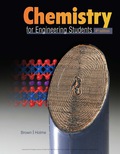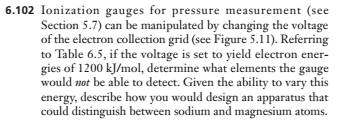
EBK CHEMISTRY FOR ENGINEERING STUDENTS,
4th Edition
ISBN: 9781337671439
Author: Holme
Publisher: CENGAGE LEARNING - CONSIGNMENT
expand_more
expand_more
format_list_bulleted
Concept explainers
Question
Chapter 6, Problem 6.102PAE

Interpretation Introduction
Interpretation:
The elements that the ionization gauge will be able to detect if the electron collection grid voltage is set to 1200 kJ/mol should be identified. In addition, an explanation must be provided explaining how the ionization gauge can be suitably modified to detect sodium and magnesium atoms.
Concept Introduction:
- The energy required to remove one (or more electrons) from an atom to form a positively charged ion (cation) is called ionization energy
- The valence electron is the most loosely bound electron in an atom which requires relatively lower energy for removal. This is the first ionization energy of an atom.
- Subsequent removal of inner electrons requires higher energy
Expert Solution & Answer
Want to see the full answer?
Check out a sample textbook solution
Students have asked these similar questions
Please help me Please use https://app.molview.com/ to draw this. I tried, but I couldn't figure out how to do it.
Propose a synthesis of 1-butanamine from the following:
(a) a chloroalkane of three carbons
(b) a chloroalkane of four carbons
Select the stronger base from each pair of compounds.
(a) H₂CNH₂ or EtzN
(b)
CI
or
NH2
NH2
(c)
.Q
or EtzN
(d)
or
(e)
N
or
(f)
H
or
H
Chapter 6 Solutions
EBK CHEMISTRY FOR ENGINEERING STUDENTS,
Ch. 6 - describe trace analysis and explain its role in...Ch. 6 - describe waves in terms of frequency, wavelength,...Ch. 6 - Prob. 3COCh. 6 - relate the frequency, wavelength, and amplitude of...Ch. 6 - describe the photoelectric effect by stating what...Ch. 6 - Prob. 6COCh. 6 - • use Planck’s equation to calculate the energy of...Ch. 6 - Prob. 8COCh. 6 - Prob. 9COCh. 6 - • describe similarities and differences between...
Ch. 6 - Prob. 11COCh. 6 - Prob. 12COCh. 6 - • identify an orbital (as 1s, 3p, etc.) from its...Ch. 6 - • list the number of orbitals of each type (1s,...Ch. 6 - • sketch the shapes of s and p orbitals and...Ch. 6 - • rank various orbitals in terms of size and...Ch. 6 - Prob. 17COCh. 6 - Prob. 18COCh. 6 - Prob. 19COCh. 6 - Prob. 20COCh. 6 - Prob. 6.1PAECh. 6 - 6.2 Unlike XRF, AAS cannot be used for...Ch. 6 - Prob. 6.3PAECh. 6 - Prob. 6.4PAECh. 6 - Prob. 6.5PAECh. 6 - Prob. 6.6PAECh. 6 - 6.7 Arrange the following regions of the...Ch. 6 - 6.8 Calculate the wavelength in meters, of...Ch. 6 - 6.9 If a string of decorative lights includes...Ch. 6 - 6.10 Define the term refraction.Ch. 6 - 6.11 Define the term photon.Ch. 6 - 6.12 Find the energy of a photon with each of the...Ch. 6 - 6.13 Place these types of radiation in order of...Ch. 6 - 6.14 For photon with the following energies,...Ch. 6 - Prob. 6.15PAECh. 6 - 6.16 Various optical disk drives rely on laser...Ch. 6 - 6.17 The laser in most supermarket barcode...Ch. 6 - 6.18 Assume that a microwave oven operates at a...Ch. 6 - 6.19 Fill in the blanks below to complete a...Ch. 6 - 6.20 When light with a wavelength of 58.5 nm...Ch. 6 - 6.21 The electron binding energy fur copper metal...Ch. 6 - Prob. 6.22PAECh. 6 - 6.23 Describe how the Bohr model of the atom...Ch. 6 - 6.24 According to the Bohr model of the atom, what...Ch. 6 - 6.25 Define the term ground state.Ch. 6 - 6.26 The figure below depicts the first four...Ch. 6 - 6.27 Refer w the data and energy-Ievel diagram...Ch. 6 - 6.28 A neon atom cmi light at many wavelengths,...Ch. 6 - 6.29 A mercury atom emits light at many...Ch. 6 - 6.30 How did the observation of electron...Ch. 6 - 6.31 Why do we use a wave function to describe...Ch. 6 - 6.32 What are the mathematical origins of quantum...Ch. 6 - Prob. 6.33PAECh. 6 - 6.34 Which of the following represent valid sets...Ch. 6 - 6.35 A particular orbital has n = 4 and l = 2....Ch. 6 - 6.36 Why are there no 2d orbitals?Ch. 6 - 6.34 What is the maximum number of electrons in an...Ch. 6 - 6.38 How many orbitals correspond to each of the...Ch. 6 - Prob. 6.39PAECh. 6 - 6.40 Referring to Figure 6.15, draw a 4p orbitals,...Ch. 6 - 6.41 Consider a 3d orbital. (a) What are the...Ch. 6 - Prob. 6.42PAECh. 6 - 6.43 Define the term spin paired.Ch. 6 - 6.44 On what does the Pauli exclusion principle...Ch. 6 - Prob. 6.45PAECh. 6 - Prob. 6.46PAECh. 6 - 6.47 Depict two ways to place electrons in the 2p...Ch. 6 - 6.48 Write the ground state electron configuration...Ch. 6 - 6.49 Which of these electron configurations are...Ch. 6 - 6.50 From the list of atoms and ions given,...Ch. 6 - Prob. 6.51PAECh. 6 - Prob. 6.52PAECh. 6 - Prob. 6.53PAECh. 6 - Prob. 6.54PAECh. 6 - 6.55 Explain why the s block of the periodic table...Ch. 6 - Prob. 6.56PAECh. 6 - Prob. 6.57PAECh. 6 - Prob. 6.58PAECh. 6 - Prob. 6.59PAECh. 6 - 6.60 Use the electron configurations of the alkali...Ch. 6 - 6.61 Using only a periodic table as a guide,...Ch. 6 - 6.62 Define the term ionization energy....Ch. 6 - 6.63 At which ionization for chlorine would you...Ch. 6 - 6.64 Arrange the following atoms in order of...Ch. 6 - Prob. 6.65PAECh. 6 - 6.66 Which element would you expect to have the...Ch. 6 - Prob. 6.67PAECh. 6 - 6.68 Indicate which species in each pair has the...Ch. 6 - 6.69 Compare the elements Na, B, Al, and C with...Ch. 6 - 6.70 Rank the following in order of decreasing...Ch. 6 - 6.71 Several excited states of the neon atom are...Ch. 6 - 6.72 LED bulbs offer a fairly new lighting...Ch. 6 - 6.73 How much energy could be saved each year by...Ch. 6 - Prob. 6.74PAECh. 6 - Prob. 6.75PAECh. 6 - Prob. 6.76PAECh. 6 - Prob. 6.77PAECh. 6 - Prob. 6.78PAECh. 6 - 6.79 How does the charge of electrons provide some...Ch. 6 - 6.80 Describe how valence electron configurations...Ch. 6 - 6.81 Why is there no element to the immediate...Ch. 6 - 6.82 A particular element has the following values...Ch. 6 - 6.83 The graph below shows the first three...Ch. 6 - 6.84 Which graph correctly depicts the first...Ch. 6 - 6.85 The visible lines in the hydrogen atom...Ch. 6 - 6.86 An excited He+ ion returns to the ground...Ch. 6 - Prob. 6.87PAECh. 6 - Prob. 6.88PAECh. 6 - Prob. 6.89PAECh. 6 - Prob. 6.90PAECh. 6 - 6.91 What is the only noble gas that does not have...Ch. 6 - 6.92 The photoelectric effect can he used to...Ch. 6 - 6.93 A mercury atom is initially in its lowest...Ch. 6 - Prob. 6.94PAECh. 6 - 6.95 A metallic sample is known to be barium,...Ch. 6 - 6.96 When a helium atom absorbs light at 58.44 nm,...Ch. 6 - 6.97 Arrange the members of each of the following...Ch. 6 - 6.98 Arrange the following sets of anions in order...Ch. 6 - 6.99 The photoelectric effect can he used in...Ch. 6 - 6.100 Some spacecraft use ion propulsion engines....Ch. 6 - 6.101 Laser welding is a technique in which a...Ch. 6 - Prob. 6.102PAECh. 6 - 6.103 Atomic absorption spectroscopy is based on...Ch. 6 - 6.104 The red color in fireworks is the result of...Ch. 6 - 6.105 When we say that the existence of atomic...Ch. 6 - 6.106 When Bohr devised his model for the atom,...Ch. 6 - Prob. 6.107PAE
Knowledge Booster
Learn more about
Need a deep-dive on the concept behind this application? Look no further. Learn more about this topic, chemistry and related others by exploring similar questions and additional content below.Similar questions
- 4. Provide a clear arrow-pushing mechanism for each of the following reactions. Do not skip proton transfers, do not combine steps, and make sure your arrows are clear enough to be interpreted without ambiguity. a. 2. 1. LDA 3. H3O+ HOarrow_forwardb. H3C CH3 H3O+ ✓ H OHarrow_forward2. Provide reagents/conditions to accomplish the following syntheses. More than one step is required in some cases. a. CH3arrow_forward
- Identify and provide an explanation that distinguishes a qualitative and quantitative chemical analysis. Provide examples.arrow_forwardIdentify and provide an explanation of the operational principles behind a Atomic Absorption Spectrometer (AAS). List the steps involved.arrow_forwardInstructions: Complete the questions in the space provided. Show all your work 1. You are trying to determine the rate law expression for a reaction that you are completing at 25°C. You measure the initial reaction rate and the starting concentrations of the reactions for 4 trials. BrO³¯ (aq) + 5Br¯ (aq) + 6H* (aq) → 3Br₂ (l) + 3H2O (l) Initial rate Trial [BrO3] [H*] [Br] (mol/L) (mol/L) | (mol/L) (mol/L.s) 1 0.10 0.10 0.10 8.0 2 0.20 0.10 0.10 16 3 0.10 0.20 0.10 16 4 0.10 0.10 0.20 32 a. Based on the above data what is the rate law expression? b. Solve for the value of k (make sure to include proper units) 2. The proposed reaction mechanism is as follows: i. ii. BrО¸¯ (aq) + H+ (aq) → HBrO3 (aq) HBrO³ (aq) + H* (aq) → H₂BrO3* (aq) iii. H₂BrO³* (aq) + Br¯ (aq) → Br₂O₂ (aq) + H2O (l) [Fast] [Medium] [Slow] iv. Br₂O₂ (aq) + 4H*(aq) + 4Br(aq) → 3Br₂ (l) + H2O (l) [Fast] Evaluate the validity of this proposed reaction. Justify your answer.arrow_forward
- a. H3C CH3 H, 1.0 equiv. Br2arrow_forwardH3C. H3C CH 3 CH 3 CH3 1. LDA 2. PhSeCl 3. H2O2arrow_forwardPlease predict the products for each of the following reactions: 1.03 2. H₂O NaNH, 1. n-BuLi 2. Mel A H₂ 10 9 0 H2SO4, H₂O HgSO4 Pd or Pt (catalyst) B 9 2 n-BuLi ♡ D2 (deuterium) Lindlar's Catalyst 1. NaNH2 2. EtBr Na, ND3 (deuterium) 2. H₂O2, NaOH 1. (Sia)2BH с Darrow_forward
arrow_back_ios
SEE MORE QUESTIONS
arrow_forward_ios
Recommended textbooks for you
 Chemistry for Engineering StudentsChemistryISBN:9781337398909Author:Lawrence S. Brown, Tom HolmePublisher:Cengage Learning
Chemistry for Engineering StudentsChemistryISBN:9781337398909Author:Lawrence S. Brown, Tom HolmePublisher:Cengage Learning ChemistryChemistryISBN:9781305957404Author:Steven S. Zumdahl, Susan A. Zumdahl, Donald J. DeCostePublisher:Cengage Learning
ChemistryChemistryISBN:9781305957404Author:Steven S. Zumdahl, Susan A. Zumdahl, Donald J. DeCostePublisher:Cengage Learning Chemistry: An Atoms First ApproachChemistryISBN:9781305079243Author:Steven S. Zumdahl, Susan A. ZumdahlPublisher:Cengage Learning
Chemistry: An Atoms First ApproachChemistryISBN:9781305079243Author:Steven S. Zumdahl, Susan A. ZumdahlPublisher:Cengage Learning
 World of Chemistry, 3rd editionChemistryISBN:9781133109655Author:Steven S. Zumdahl, Susan L. Zumdahl, Donald J. DeCostePublisher:Brooks / Cole / Cengage Learning
World of Chemistry, 3rd editionChemistryISBN:9781133109655Author:Steven S. Zumdahl, Susan L. Zumdahl, Donald J. DeCostePublisher:Brooks / Cole / Cengage Learning General Chemistry - Standalone book (MindTap Cour...ChemistryISBN:9781305580343Author:Steven D. Gammon, Ebbing, Darrell Ebbing, Steven D., Darrell; Gammon, Darrell Ebbing; Steven D. Gammon, Darrell D.; Gammon, Ebbing; Steven D. Gammon; DarrellPublisher:Cengage Learning
General Chemistry - Standalone book (MindTap Cour...ChemistryISBN:9781305580343Author:Steven D. Gammon, Ebbing, Darrell Ebbing, Steven D., Darrell; Gammon, Darrell Ebbing; Steven D. Gammon, Darrell D.; Gammon, Ebbing; Steven D. Gammon; DarrellPublisher:Cengage Learning

Chemistry for Engineering Students
Chemistry
ISBN:9781337398909
Author:Lawrence S. Brown, Tom Holme
Publisher:Cengage Learning

Chemistry
Chemistry
ISBN:9781305957404
Author:Steven S. Zumdahl, Susan A. Zumdahl, Donald J. DeCoste
Publisher:Cengage Learning

Chemistry: An Atoms First Approach
Chemistry
ISBN:9781305079243
Author:Steven S. Zumdahl, Susan A. Zumdahl
Publisher:Cengage Learning


World of Chemistry, 3rd edition
Chemistry
ISBN:9781133109655
Author:Steven S. Zumdahl, Susan L. Zumdahl, Donald J. DeCoste
Publisher:Brooks / Cole / Cengage Learning

General Chemistry - Standalone book (MindTap Cour...
Chemistry
ISBN:9781305580343
Author:Steven D. Gammon, Ebbing, Darrell Ebbing, Steven D., Darrell; Gammon, Darrell Ebbing; Steven D. Gammon, Darrell D.; Gammon, Ebbing; Steven D. Gammon; Darrell
Publisher:Cengage Learning
Types of bonds; Author: Edspira;https://www.youtube.com/watch?v=Jj0V01Arebk;License: Standard YouTube License, CC-BY